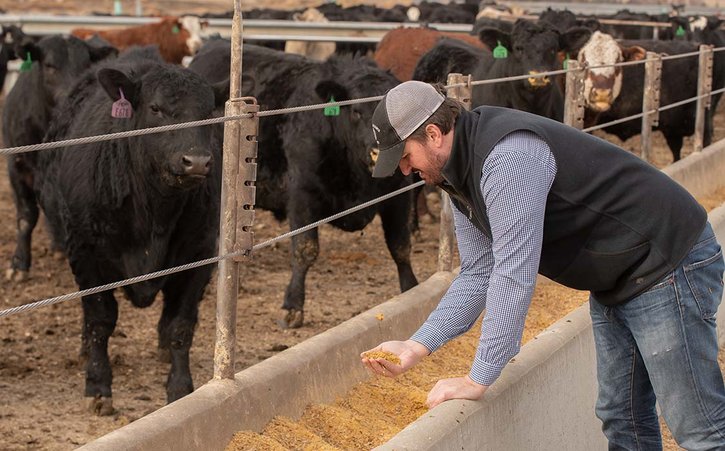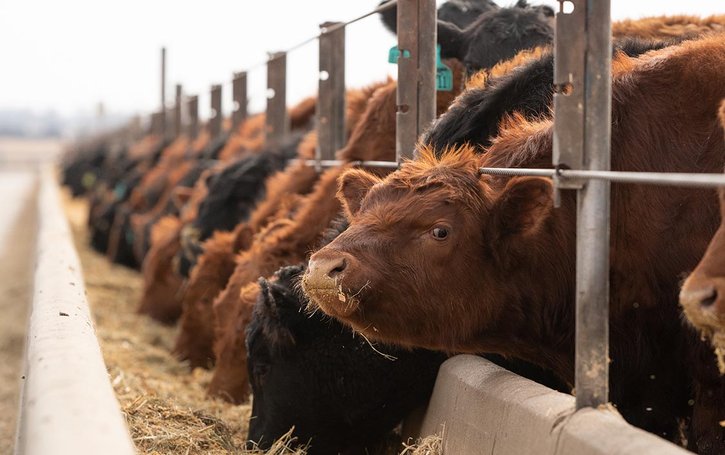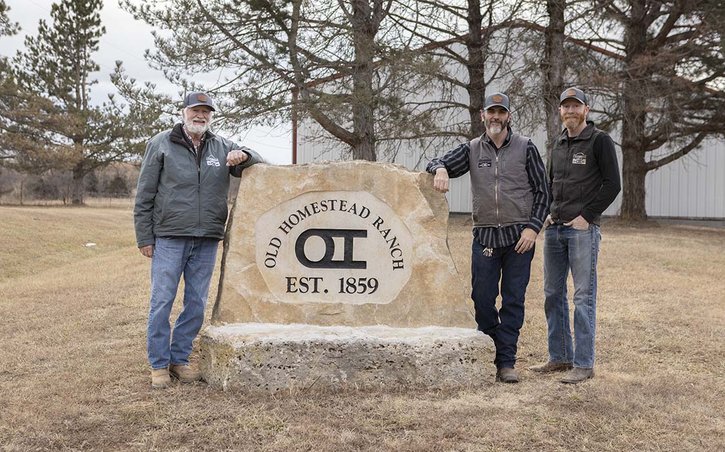Steve Sunderman has faced a lot of challenges in recent years.
As a part of the cattle industry, Sunderman’s business has withstood the effects of a cybersecurity attack, severe weather, labor shortages and a pandemic – all within a complex industry with narrow profit margins and a not-so-nimble commodity.
But as a member of a family business that has operated in Madison County, Nebraska, since the 1880s, Sunderman has perspective.
“Being in agriculture has always had its challenges,” Sunderman said. “Seeing what we have gone through in the last couple of years gives you an appreciation of those that had it just as hard or maybe harder depending on the situation they were in whether it was drought like the Dust Bowl or previous pandemics or wars.”
The U.S. cattle industry might be at another turning point, according to a December 2021 Economic Review paper, “Long-Term Pressures and Prospects for the U.S. Cattle Industry,” by Kansas City Fed Senior Economist Cortney Cowley.
Cowley’s research concludes that as it comes out of the pandemic, U.S. cattle production faces three key pressures that may affect profitability in the future: vulnerabilities along the supply chain; extreme weather conditions, particularly drought; and shifting demand from U.S. consumers.
Sunderman, whose operations include a feedlot with a capacity of 20,000 head of cattle, said he is ready.
“Quite frankly, if you are not resilient, you’re not going be able to stay in this industry,” Sunderman said. “Challenges are just a part of it.”

Steve Sunderman’s family’s farm near Norfolk, Nebraska, has been in operation for more than 130 years. Photo by Jake Wragge
An intricate structure
Whatever challenges producers are facing, the biggest might actually be how the industry itself operates.
“I believe the U.S. beef industry in totality is the most complex set of markets on the planet,” said Derrell Peel, extension livestock marketing specialist at Oklahoma State University in Stillwater. “It’s vastly complex just to get animals to the point of slaughter, because we produce them in multiple production sectors … we move them all over the country and in all sorts of environments. Then we get them to that point where we harvest those animals … we fabricate them … and then it gets really complicated because we turn those animals into many thousands of different products in markets that all interact with each other. When you put all of that together it’s just an enormously complex industry.”
Cowley said the cattle industry’s elaborate production structure means a single cow could be sold as many as six times before reaching a consumer, and all along that chain are economic dynamics.
Efforts to become more efficient have resulted in meatpackers producing higher quantities of meat with fewer cows, while selective breeding and technologies such as artificial insemination are helping the industry produce more beef per cow, Cowley said.
The end result is the pounds of beef produced per head and the total amount of beef in the United States have increased.
Because beef production and processing are expensive and capital-intensive, the U.S. meatpacking industry has been consolidating. And in an attempt to match demand with supply to reduce excess capacity, the industry is moving to “just-in-time” inventory management, in which cattle are shipped to packing plants and slaughtered as soon as they mature.
Added to the complexities is the fact that beef is a cumbersome commodity compared with other mass-produced meats.
Cowley said cattle’s longer production cycles means that any shocks or backlogs within the supply chain can take longer to work through and have more lasting effects on prices.
“They can’t turn on a dime, so to speak, to adjust supply or herd sizes based on market condition,” Cowley said.
By comparison, poultry producers are quite nimble in reacting to shocks.
“The poultry producers can make changes week one,” Cowley said. “The pandemic happened, and they started making adjustments. Hogs are very similar.”
While a cow has one calf a year, a sow can have as many as 30 piglets a year. And, both poultry and hogs can be processed quicker than cattle.
“I think the pandemic really exposed how different the cattle industry is apart from all other commodities,” Cowley said.

The Sunderman family’s Madison County, Nebraska, operation includes feedlot capacity for up to 20,000 head of cattle. Photo by Jake Wragge
‘Very unique situation’
Beef is an important commodity for the Tenth District of the Federal Reserve. As such, the industry is watched closely along with other top commodities, such as corn, soybeans, wheat and hogs. Notably those commodities are the top five commodities for the United States as a whole.
While reviewing these commodities through the initial phase of the pandemic there was something quite noticeable, Cowley said.
All commodities—except cattle—were rebounding sharply regarding prices that producers could get by the fourth quarter of 2020. Cattle prices stayed below pre-pandemic levels until fall 2021.
“That’s what really got us to thinking deeply about ‘How is the cattle industry different, and why are they facing so much more pressure than the other commodities,’ ” Cowley said.
The cattle industry endured a slew of issues over the last two years, with COVID outbreaks shutting down or slowing work at meatpacking and processing plants, along with bouts of extreme weather and cyberattacks that stalled one of the largest meatpackers in the country.
Cowley said supply and backlogs were weighing down prices at the same time there was a roadblock of demand from reduced capacity at meatpacking plants.
“Very unique situation,” Cowley said. “Very unprecedented.”
Cowley said the disruptions increased consumer interest in locally sourced beef and may have spurred new ways to improve resilience, information transmission and automation in the industry.
Michael Gunderson, head of agriculture research and strategy at MetLife Investment Management, said plant closures, rising packer margins and concerns around pricing transparency have intensified the pressures to diversify production systems.
“There will always be a demand for low-cost protein, and the sector is proficient in leveraging operational efficiencies during normal times,” said Gunderson.
“The growing demand for protein exports suggests that production expectations on these facilities are only likely to increase. This growth is happening as consumers are also demanding additional characteristics in beef—grass-fed, USDA prime and hormone-free as examples—where some producers will have an edge in product differentiation leadership.”
He said that many producers are finding success in direct-to-consumer marketing, often selling half of an animal to a single customer who can store the meat in a freezer.
“Many producers seem to prefer this arrangement for its customer intimacy, even if there isn’t a substantial price premium, finding satisfaction in cutting out the middleman,” Gunderson said.
That’s what Lucas Cosgrove of Council Grove, Kansas, has seen. His family’s farm, Old Homestead Ranch, was homesteaded in 1859.
“Early on in the pandemic, I personally watched a Facebook group called ‘Shop Kansas Farms’ explode with local and regional interest due to the bottlenecks in production from the packers,” Cosgrove said. “Those shortages at supermarkets of beef and other protein led the consumers to search elsewhere. Those who joined that group immediately found themselves making direct contact with smaller regional producers for the first time in their lives to purchase beef direct.”
But there are challenges, Cosgrove said.
“Most ranchers already have too much on their plate to endure those challenges for razor-thin margins,” he said. “Ranching is too much work just be their ‘temporary’ meat provider in a time of chaos.”
And high demand in buying direct then created its own backlog.
“Quite frankly it proves there are not enough operational small lockers and butchers to fill that immediate demand to stabilize our food supply,” Cosgrove said.

(From left) John Cosgrove and his sons, Lucas and Jeremy Cosgrove, at their family’s cattle farm near Council Grove, Kansas. Photo by Gary Barber
Prospects and potential
Looking ahead, Gunderson said the cattle industry is examining three key topics: the need for slack and resiliency in the system, the need for greater transparency across the sector, and the need to balance the costs of ensuring food safety and the success of small meat processing.
The pandemic revealed the challenges of having a highly concentrated, highly efficient system that suffers hugely with one plant closing.
“Processors may reconsider the true efficiency of these facilities more broadly than simply cents per pound of meat,” Gunderson said. “Congressional inquiries and industry actions suggest that the current pricing mechanisms are not widely acceptable. There appears to be change on the horizon regarding how live cattle markets will function in the future.”
Looking at the smaller producers, Gunderson said while the Department of Agriculture does a fine job of ensuring food safety, some small processors point to the costs of USDA inspectors and other regulatory burdens as the reasons for limited success.
Cosgrove, the Kansas rancher, thinks banks and government need to make a real renewed interest in small local ranchers markets.
“By encouraging small local butcher businesses to flourish and providing start-up aid, that gives small business entrepreneurs in the beef industry incentive to start or expand,” Cosgrove said. “This is what could really strengthen the supply chain for our food and give economic relief for ranchers that actually care about the livestock they raise.”
Katelyn McCullock, director of the Livestock Marketing Information Center in Denver, said that while the U.S. consumer is the primary focus of this country’s beef industry, China emerged as a top-three buyer of U.S. beef in 2021.
“In the medium term, the U.S. beef industry will very likely need to shift a greater focus to consumers outside its borders,” she said.
What is difficult to forecast, McCullock said, is the effect that supply chain changes will have.
“We are living through the aftermath of a colossal shock … but the changes we make can improve supply chain resiliency … and push the cattle industry into its newest evolution to adapt to the challenges and demands of the future,” she said.
What Sunderman found surprising—yet encouraging for the future—was the strong demand for beef in the last two or three years.
“There are very, very, very few people who would have guessed we would have seen beef prices where we did,” he said. “No one would have thought that domestic consumers and those abroad would be willing to be pay that much for it.”
Now, Sunderman said, the cattle industry needs to continue to grow supply and meet demand—and keep beef affordable while trying to solve supply issues.
“That is the challenge but also the opportunity. Because I want people to enjoy beef and do it regularly.”
Read Economic Review articles and other research from the Kansas City Fed.
Learn more about Senior Economist Cortney Cowley and her family's background in cattle farming.
